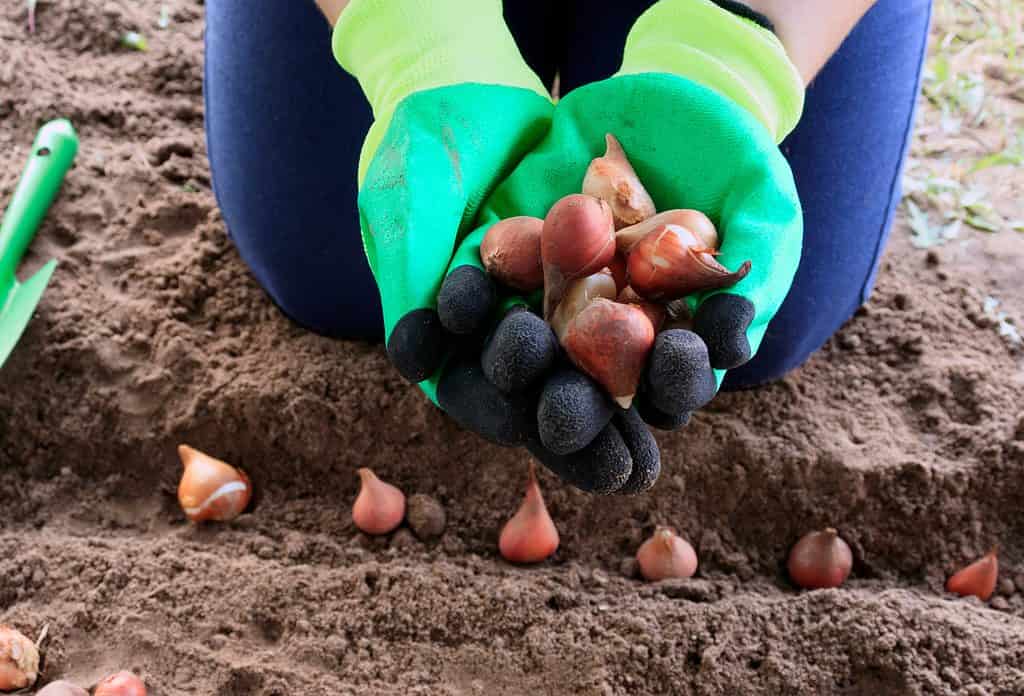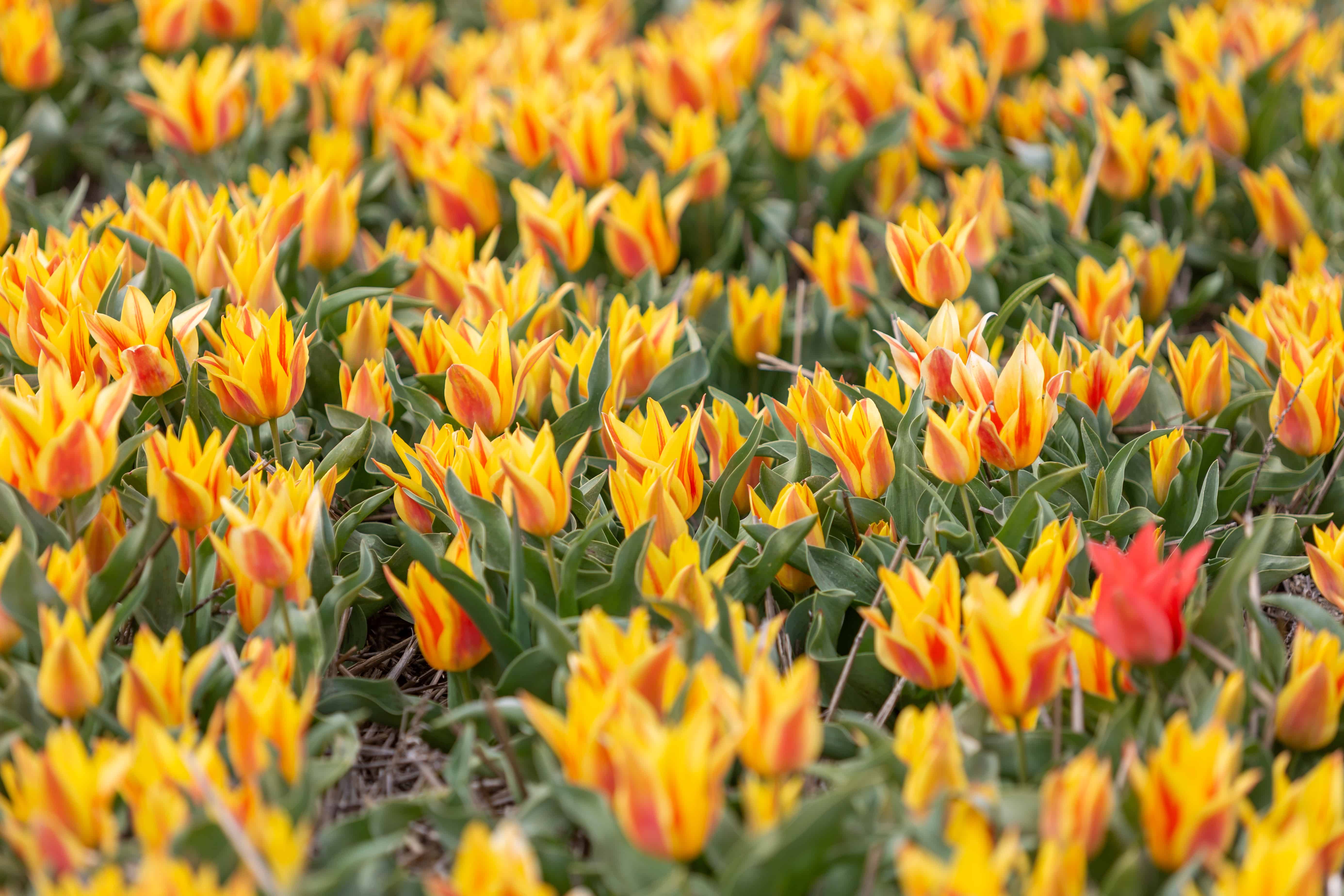USDA hardiness zones three to five cover Montana (MT). Thankfully, many bulbous plants may be grown in those areas. Zones three to five hardy bulbs like tulips should be planted in autumn, before the first frost. Whereas, zone five delicate bulbs should be sown in the spring, following the last frost of the year.
Even while tulips are unique and should be planted according to their type, they can be planted in a comparable way as other bulb plants.

USDA hardiness zones three to five cover Montana (MT). Thankfully, many bulbous plants may be grown in those areas.
©SirWeAre/Shutterstock.com
The Montana Tulip
On sturdy tall stems with several slender, spear-shaped, undulating, channeled leaves that are rimmed in red, this tulip bears lone, dazzling deep red, bowl-shaped flowers. The preferred spring bulb for ages has been the tulip.
This bulb is classified as an annual where summers are hot and long since it thrives where summers are dry and winters are cold. Tulips are a genus with over 100 species that are split into 15 distinct divisions. Tulips can be utilized in rock gardens, pots, overplanting above perennials, taken indoors, and as cut flowers. They are best planted in huge drifts.
How to Plant Tulips in Montana

Till the first 12 inches of the soil. Add three to four inches of compost or peat moss to make the soil more permeable and well-draining.
©Natallia Ustsinava/Shutterstock.com
Choose a spot that receives both full light and some shade. The majority of bulbous plants require four to six hours of sunlight per day to grow. Till the first 12 inches of the soil. Add three to four inches of compost or peat moss to make the soil more permeable and well-draining. This is crucial in Montana because excessively wet soil may freeze and thaw more frequently than in other regions, even in the autumn and spring seasons. Your bulbs may suffer from this severe variation in soil temperature, which will prevent them from blooming.
Find the Perfect Spot
Start by making holes that are two to three times as deep as the bulbs’ width. Depending on the type of bulb, the spacing will vary. Snowdrops only require three inches of space while lilies require 10 to 12 inches.
Planting depths for tulips, hyacinths, and daffodils should range from six to eight inches. The depths for grape hyacinths and glacier lilies should be four inches.
Make sure to plant bulbs that are actually corms, rhizomes, or tubers according to their specific requirements since they are planted uniquely from true bulbs. With their tips pointing up, plant the bulbs in the ground. Gently compact the dirt and apply a couple of inches of water to the planting area.
Prepare for Weather
Mulch the area and cover it. Provide four to six inches of mulch, such as straw, bark, or pine needles, around hardy bulb planting sites, particularly in zones three and four. By doing this, the bulbs will have more time to establish themselves before the ground freezes. A few inches of mulch will help stop the soil from thawing and refreezing when you plant fragile bulbs in the spring.
Leave the foliage on your bulbs and allow it to gradually wither away. This nourishes the bulbs and promotes healthy flowering the next year. After the foliage has died down, many bulbs, notably tulips, prefer dry soil conditions.
Some dig out their tulip bulbs, store them, and then transplant them in the fall in some climes or if summer bedding is intended for that location. In Montana, if you don’t provide any more summer water, you can keep the bulbs in the ground. Wait until October to water them. Before watering your bulb beds, put bone meal over them to help the roots grow before winter.
Skagit Valley Tulip Festival

The Skagit Valley Tulip Festival is the second-biggest tulip festival in the country.
©Ganeshkumar Durai/Shutterstock.com
If you have a love for these stunning flowers and want to go on an adventure, consider crossing the border into Washington for the Skagit Valley Tulip Festival! The second-biggest tulip festival in the country, it includes tulip fields, display gardens, activities, and festivities. Four farms are included in the Skagit Valley Tulip Festival: RoozenGaarde, Tulip Town, Tulip Valley Farms, and Garden Rosalyn.
The tulip has long been considered a representation of earthly paradise. They warmly invite visitors from Montana to the Magic Skagit Valley, a contemporary paradise on earth, where during the annual Skagit Valley Tulip Festival in April millions of tulips blossom!
Enchanting Skagit is at its best during the Skagit Valley Tulip Festival! The coasts of the Salish Sea, ports, islands, hills, the Skagit River, and one of the biggest and most diverse agricultural regions west of the Cascade mountain range are among the natural attractions of the Magic Skagit Valley.
Throughout the year and during the Skagit Valley Tulip Festival, tourists should enjoy a lovely drive around the Valley to learn about farming. There are more tulip and daffodil bulbs grown there than in any other area in the United States. Local farmers cultivate 90 different crops, cattle, and dairy products worth around $261 million on 93,000 acres of land.
Thank you for reading! Have some feedback for us? Contact the AZ Animals editorial team.








